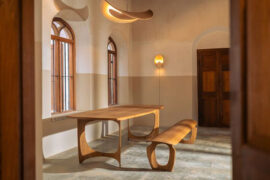This Tin Sheds Gallery exhibition delves into complexity and contradiction in the Hunter Region in the context of coal and climate crisis.

Jennifer Ferng and Daniel Ryan.
November 13th, 2024
Set within the School of Architecture, Design and Planning at the University of Sydney, Tin Sheds Gallery has a proud history of protest-driven and socially engaged exhibitions. The latest, Monumental Imaginaries, focuses on the coal of the Hunter Region in New South Wales. In particular, it showcases the intersections of visual culture and questions of energy transition – from political art to architectural drawings and sculptures.
The exhibition is presented with the support of the Sydney Environment Institute, Arts and Humanities Research Council UK, Powerhouse Museum, Mogu, Surfrider Foundation, Tony Song (Boral), the University of Newcastle and the Volpato family. Daniel Ryan co-curated it alongside Jennifer Ferng, and he explains the overall focus: “We’re keen to get out of simply looking at energy transition in terms of architecture to include how different disciplines look at it, but also to explore that there is a visual culture of energy transition too.”

Organised into multiple parts, the show features multimedia works including video projections, photography, drawings, sculptures and more, all arranged around a focal point that makes a poignant historical reference. ‘Hewing. Shipping.’ by Luke Ryan O’Connor is set in a central space to be seen in the round, acting as a point of reimagination in relation to Newcastle’s Jubilee Coal Monument – a monument built 115 years ago by a City of Newcastle enthralled by coal.
“We thought it would be provocative to focus the show around the monument because of its contradictions,” adds Ryan.
Related: Replica Autoprogettazione at Tin Sheds

By embedding questions of energy transition and fossil fuel damage in a specific place, the exhibition adds a human dimension to questions that can obviously be read on a global scale of crisis. The attachment of this city and region to coal is seen in its historical context, one in which the industry at one time represented righteous labour struggles and industrial action more than climate change. “There can be a tendency to talk about energy transition as if the lives of people who work there don’t matter,” notes Ryan, a prompt to remind visitors that urgent climate justice also urgently requires justice for workers in such areas.
Monumental Imaginaries takes us first to questions of fossil fuel legacies. Merilyn Fairskye in ‘Yesterday New Future (Liddell)’ (on loan from the Powerhouse Museum) captures the transition of the Liddell Power Station in the Hunter Valley, considering the site as a microcosm of geological time, human settlement and industrial transformation.

“Academics often discuss energy transition purely in technical terms,” says Ryan. “Yet, at the same time, there exists a culture of protest enabling energy transition, so we were keen to highlight some of the imagery around that.” The visual culture focus also allows for a sense of imagining different futures, “a kind of ‘climate imaginary’ based on sustainable lifestyles,” as Ryan adds.
One important aim of the exhibition is to depict the scale of the fossil legacy, whether that means looking at the mines themselves or the power centres. It was then “to highlight some of the culture of protest that comes with it, and the shifting sensibility in the area about future architecture,” explains Ryan.

Other areas set out in the gallery concentrate on themes of community, counter-monuments and emerging programs. Architectural pieces are presented from practices including Prevalent and Collins and Turner Architects, while the 1966 Munmorah Power Station Mural by Italian-born architect Gino Volpato is on show in digital form, having been carefully scanned and dismantled in 2017 before becoming part of the Powerhouse collection.
Monumental Imaginaries is at Tin Sheds Gallery, Sydney from 10th October to 15th November.
Tin Sheds Gallery
sydney.edu.au
Photography
Maja Baska Photography courtesy of Tin Sheds Gallery













Read about a previous exhibition on radio and protest culture here
INDESIGN is on instagram
Follow @indesignlive
A searchable and comprehensive guide for specifying leading products and their suppliers
Keep up to date with the latest and greatest from our industry BFF's!

Welcomed to the Australian design scene in 2024, Kokuyo is set to redefine collaboration, bringing its unique blend of colour and function to individuals and corporations, designed to be used Any Way!
The new range features slabs with warm, earthy palettes that lend a sense of organic luxury to every space.

London-based design duo Raw Edges have joined forces with Established & Sons and Tongue & Groove to introduce Wall to Wall – a hand-stained, “living collection” that transforms parquet flooring into a canvas of colour, pattern, and possibility.

Poised at the intersection of design and service, King Trade has launched a new dedicated hub in Bondi Junction, which offers tailored product, service and pricing for architects and interior designers.

‘The Mandate Mirage: 2025 Workplace Futures Survey’ is a new report by international design practice Hassell, revealing that the real drawcard for attracting employees to the office in-person is choice.
The internet never sleeps! Here's the stuff you might have missed

From Australian architects to Spanish and Indian designers, Design Mumbai 2025 expands its international reach — proving India’s growing role on the global design stage.

Arper expands its outdoor offer by re-engineering some of its most recognisable indoor pieces for life outside.